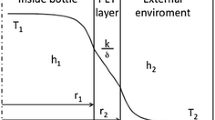Abstract
In this study, a series of experimental studies were carried out for the production of 0.5 L/22 g shampoo bottles in the pet blowing machine of which produces pet bottles in Turkey. In the experimental study, some of the factors that the plastic bottle encounters during production; suitable production parameters were established by optimizing the temperature, pressure, stretch bar distance setting experimentally. It is aimed to eliminate production errors such as not forming bottles, bursting during inflation, tearing of the bottle during production, whitening, folding at the bottom, slipping of the bottom, which are especially seen in the final products. Plastic bottle encounters during production; temperature, pressure, stretch bar distance setting were optimized experimentally and appropriate production parameters were established.












Similar content being viewed by others
Abbreviations
- ISBM:
-
Injection stretch blow molding
- IR:
-
Infrared lights
- PET:
-
Polietilen Tereftalat
References
Rosato, D. V. (2020). Behave: The complete blow molding operations. Hanser Books.
Timur, M., & Kılıç, H. (2021). Hole in pet bottle production as well as root causes of leakage problem and solution of the problem” 4. In International conference on materials science, mechanical and automotive engineering’s and technology (IMSMATEC’21), Türkiye.
Billon, N. (2023). Strain induced crystallization of PET under biaxial conditions. From laboratory tests to injection stretch-blow molding. Polymer, 277, 125953. https://doi.org/10.1016/j.polymer
Timur, M. (2023). Determination of needs the production of 5 L pet bottles and cost analysis. Packaging Technology and Science, 36(3), 219–226. https://doi.org/10.1002/pts.2706
Hsieh, P. C. (2023). Intelligent temperature control of a stretch blow molding machine using deep reinforcement learning. Processes, 11, 1872. https://doi.org/10.3390/pr11071872
Luo, Y.-M., Yakam, T., & CharlotChevalierSavajano, G. R. L. (2023). In situ adjustment of a visco hyper elastic model for stretch blow molding process simulation of polyethylene terephthalate bottles. Polymer Engineering & Science. https://doi.org/10.1002/pen.26428
(2023). https://www.toshiba-lighting.com/product/industry-short-wave-infrared-emitters
Attar, H., Luo, Y. M., Chevalier, L., Nguyen, T., & Detrez, F. (2022). Identification of anisotropic properties of polymer sheets from heterogeneous biaxial tests. Polymer Testing, 115, 107721. https://doi.org/10.1016/j.polymertesting.2022.107721
Le, A. D., Gilblas, R., Lucin, V., Maoult, Y. L., & Schmidt, F. (2022). Infrared heating modeling of recycled PET preforms in injection stretch blow molding process. International Journal of Thermal Sciences. https://doi.org/10.1016/j.ijthermalsci.2022.107762
Timur, M., & Kılıç, H. (2021). Whitening defects in plastic bottle production in industry and solution recommedations. In: International conference on materials science, mechanical and automotive engineerings and technology (IMSMATEC’21), Türkiye.
Demirel, B., Akkurt, F., Adeviye, İU., & Senyiğit, E. (2022). De termination of the best injection stretch blow molding process parameters in polyethylene terephthalate bottle service performance. Gazi University Journal of Science, 35(4), 1297–1316. https://doi.org/10.35378/gujs.704371
Chandra, R. B. J., Shivamurthy, B., Vishwanatha, H. M., & Kumar, M. S. (2023). Tensile and thermal behaviour of linear low-density polyethylene nanocomposite films. Materials Science and Engineering. https://doi.org/10.1088/1757-899X/1272/1/012024
Hardving, K., Michali, W. (2018) 53th annual technic conference, Boston, USA
Kocayavuz, O., Demirel, B., Yaraş, A., Akkurt, F., & Daver, F. A. (2022). A way to enhance the mechanical performance and UV visible-light barrier of polyethylene terephthalate packaging material: synthesis and application of takedaite (Ca3B2O6). Polymers for Advanced Technologies, 33(10), 3359–3367. https://doi.org/10.1002/pat.5786
Arias-Nava, E. H., Valles-Rosales, D. J., & Sullivan, B. P. (2023). Biopolymer non-parametric analysis: A degradation study under accelerated destructive tests. Polymers, 15, 620. https://doi.org/10.3390/polym15030620
Abbas, Z., Wang, D., Lu, L., et al. (2022). The focused electrode ring for electro hydro dynamic jet and printing on insulated substrate. International Journal of Precision Engineering and Manufacturing, 23, 545–563. https://doi.org/10.1007/s12541-022-00634-1
Koo, S., Lee, S. H., & Kim, J. D. (2016). Controlled airbrush coating of polymer resists in Roll-to-Roll nanoimprinting with regimented residual layer thickness. International Journal of Precision Engineering and Manufacturing, 17, 943–947. https://doi.org/10.1007/s12541-016-0115-8
Lyu, M. Y., & Choi, T. G. (2015). Research trends in polymer materials for use in light weight vehicles. International Journal of Precision Engineering and Manufacturing, 16, 213–220. https://doi.org/10.1007/s12541-015-0029-x
Green, S., Song, S., & Kim, B. (2020). Fabrication of channel circuit electrodes and flexible graphene resistive sensors for detecting dinitrotoluene 2,4 (DNT). International Journal of Precision Engineering and Manufacturing, 21, 1943–1953. https://doi.org/10.1007/s12541-020-00391-z
Nguyen, H. A. D., Shin, K., & Lee, C. (2015). Effect of nip force on ink transfer in high resolution roll-to-roll printing. International Journal of Precision Engineering and Manufacturing, 16, 517–523. https://doi.org/10.1007/s12541-015-0070-9
Dix, S. (2023). Foam-core multilayer blow molding: How it’s done. Plastics Technology, 69(8), 32–37.
Acknowledgements
This study was carried out in a practical application in the Plastic Packaging Industry of plant.
Author information
Authors and Affiliations
Corresponding author
Additional information
Publisher's Note
Springer Nature remains neutral with regard to jurisdictional claims in published maps and institutional affiliations.
Rights and permissions
Springer Nature or its licensor (e.g. a society or other partner) holds exclusive rights to this article under a publishing agreement with the author(s) or other rightsholder(s); author self-archiving of the accepted manuscript version of this article is solely governed by the terms of such publishing agreement and applicable law.
About this article
Cite this article
Timur, M. The Effect of Temperature, Pressure and Stretch Bar on Product Quality in Production of 0.5 L Pet Bottle. Int. J. Precis. Eng. Manuf. 24, 2229–2237 (2023). https://doi.org/10.1007/s12541-023-00899-0
Received:
Revised:
Accepted:
Published:
Issue Date:
DOI: https://doi.org/10.1007/s12541-023-00899-0




